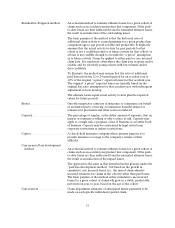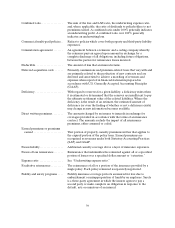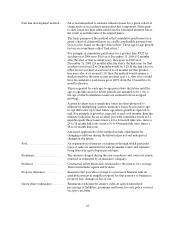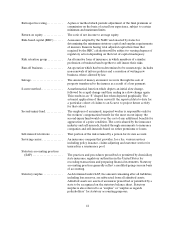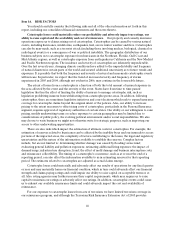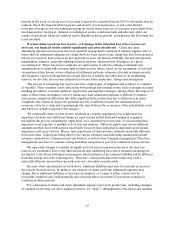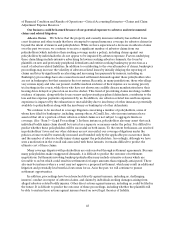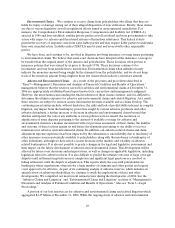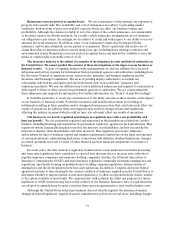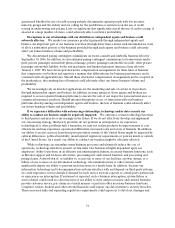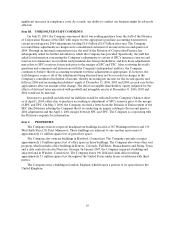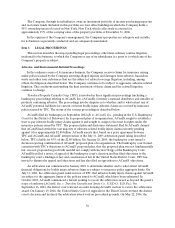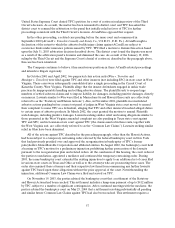Travelers 2006 Annual Report Download - page 59
Download and view the complete annual report
Please find page 59 of the 2006 Travelers annual report below. You can navigate through the pages in the report by either clicking on the pages listed below, or by using the keyword search tool below to find specific information within the annual report.47
benefits in the event of certain acts of terrorism, it may not be extended beyond 2007 or its benefits may be
reduced. Given the unpredictable frequency and severity of terrorism losses, as well as the limited
terrorism coverage in our own reinsurance program, future losses from acts of terrorism, particularly those
involving nuclear, biological, chemical or radiological events, could materially and adversely affect our
results of operations, financial condition and/or liquidity in future periods, particularly if the Terrorism Act
is not extended.
If actual claims exceed our loss reserves, or if changes in the estimated level of loss reserves are
necessary, our financial results could be significantly and adverselyaffected. Claim and claim
adjustment expense reserves (loss reserves) represent management’s estimate of ultimate unpaid costs of
losses and loss adjustment expenses for claims that have been reported and claims that have been incurred
but not yet reported. Loss reserves do not represent an exact calculation of liability, but instead represent
management estimates, generally utilizing actuarial expertise and projection techniques, at agiven
accounting date. These loss reserve estimates are expectations of what the ultimate settlement and
administration of claims will cost upon final resolution in thefuture, based on our assessment of facts and
circumstances then known, review of historical settlement patterns, estimates of trends in claims severity
and frequency, expected interpretations of legal theories of liability and other factors. In establishing
reserves, we also take into account estimated recoveries from reinsurance, salvage and subrogation.
The process of estimating loss reserves involves a high degree of judgment and is subject to a number
of variables. These variables can be affected by both internal and external events, such as changes in claims
handling procedures, economic inflation, legal trends and legislative changes, among others. The impact of
many of these items on ultimate costs for claims and claim adjustment expenses is difficult to estimate.
Loss reserve estimation difficulties also differ significantly by product line due to differences in claim
complexity, the volume of claims, the potential severity of individual claims, the determination of
occurrence date for a claim and reporting lags (the time between the occurrence of the policyholder event
and when it is actually reported to the insurer).
We continually refine our loss reserve estimates in a regular ongoing process as historical loss
experience develops and additional claims are reported and settled. Informed judgment is applied
throughout the process, including the application, ona consistent basis over time, of various individual
experiences and expertise to multiple sets of data and analyses. Different experts may choose different
assumptions when faced with material uncertainty, based on their individual backgrounds, professional
experiences and areas of focus. Hence, such experts may at times produce estimates materially different
from each other. Experts providing input tothe various estimates and underlying assumptions include
actuaries, underwriters, claim personnel and lawyers, as well as other Company management. Therefore,
management may have to consider varying individual viewpoints as part of its estimation of loss reserves.
We rigorously attempt to consider all significant facts and circumstances known at the time loss
reserves are established. Due to the inherent uncertainty underlying loss reserve estimates including but
not limited to the future settlement environment, final resolution of the estimated liability will be different
from that anticipated at the reporting date. Therefore, actual paid losses in the future may yield a
materially different amount than currently reserved—favorable or unfavorable.
Because of the uncertainties set forth above, additional liabilities may arise for amounts in excess of
the current related reserves. In addition, our estimate of claims and claim adjustment expenses may
change. These additional liabilities or increases in estimates, or a range of either, cannot now be
reasonably estimated and couldmaterially and adversely affect our results of operations or financial
condition in future periods.
For a discussion of claims and claim adjustmentexpense reserves by product line, including examples
of common factors that can affect required reserves, see “Item 7—Management’s Discussion andAnalysis


